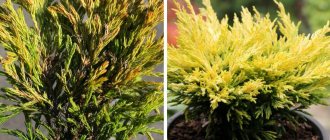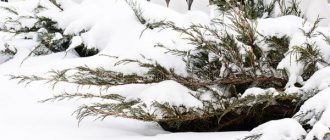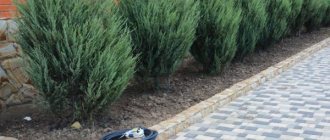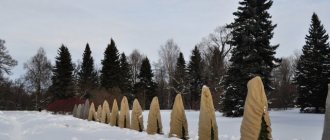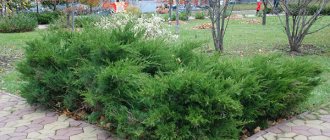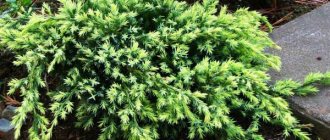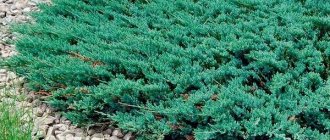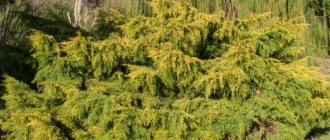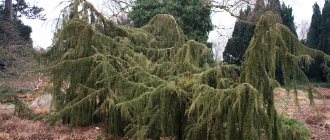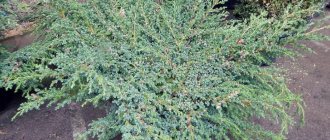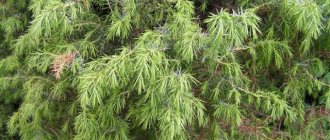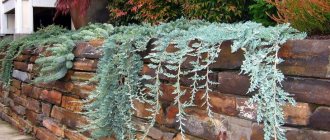Blue Alps juniper has been used for landscaping for many years. It can be found in the vastness of the Caucasus, Crimea, Japan, China and Korea. The variety is undemanding in care, so even a beginner can cope with growing it in a summer cottage.
Chinese juniper Blue Alps: variety description
Like other junipers, the Blue Alps variety (Juniperus chinensis Blue Alps) is a long-lived evergreen coniferous shrub. Depending on environmental conditions, the lifespan of juniper bushes can range from several centuries to thousands of years. The Chinese juniper variety “Blue Alps” belongs to the tall varieties: the height of an adult bush varies on average from 3-4 m, the plant reaches such indicators by 10 years. The average diameter of the crown is 2 m. The branches of the Blue Alps juniper are directed upward and are distinguished by the strength and lushness of the coniferous cover. The needles of "Blue Alps" are small (up to 1 cm) hard, sharp spines. The annual growth of shoots, as a rule, ranges from 0.1 to 0.2 m. The crown color of an adult Blue Alps juniper bush is green with a tint of emerald and silver tones. Among the junipers of this variety there are both monoecious and dioecious specimens. During the fruiting period, the lush bluish-green needles of “Blue Alps” are covered with black-green spots of fruit, which are small cones covered with a grayish-white coating. The diameter of Blue Alps juniper fruits averages 5-10 mm. Each of them consists of scales ranging from 4 to 8 and includes a couple of seeds.
Despite its attractive appearance, Blue Alps juniper is not harmless - all its parts contain toxic essential oils that are dangerous to humans and animals. The fruits of this plant are unsuitable for food and can cause severe poisoning. "Blue Alps" is a not too capricious variety that does not require particularly nutritious soils and can grow on dry and rocky soils. Like other junipers, it is quite light-loving and does not tolerate stagnant moisture in the soil. But it is resistant to drought and severe frosts and successfully takes root even in the northern regions.
Growing regions
This frost-resistant crop can safely withstand short-term frosts down to -29°C. Without shelter, it is cultivated in the south, in the middle zone.
In the Center, the Urals, the North and Siberia, seedlings must be insulated in the first years of life.
Among the main advantages of the variety are its compact size, unpretentiousness in care and maintenance conditions, the beautiful color of the needles, which does not change all year round, thins the rich pine aroma, which repels harmful insects. This conifer also tolerates drought and wind well.
Chinese juniper Blue Alps in landscape design
Due to its compactness and balanced size, Blue Alps juniper is favored by garden design masters. The beautiful color scheme in silver-green tones adds attractiveness to its bushes. Placing juniper in a garden plot will not only create year-round greenery, but will also serve to purify the air in the garden. The fragrant branches of juniper bushes not only deodorize the surrounding space, but also act as a natural antiseptic that helps destroy pathogenic microorganisms.
Blue Alps juniper formation in Bonsai
The neat crowns of Blue Alps juniper look equally impressive both as single dominants and in combination with other plants. Juniper is a friendly neighbor that will easily keep company with other coniferous crops, deciduous and herbaceous plants. Blue Alps is often used to form living borders and hedges, to create bonsai-style compositions, to plant terraces and lawns, to revitalize alpine hills and rockeries.
For roses and other lush flowering crops, the emerald-silver needles of Blue Alps provide an excellent backdrop. Unpretentious juniper bushes are insensitive to polluted air in the urban environment, therefore they are widely used for landscaping industrial facilities, parks and squares, areas around medical and educational institutions. Green juniper hedges are planted along highways.
Reviews
This crop has gained great popularity and positive reviews among gardeners due to several qualities:
- high decorative value throughout the year, good resistance to cold;
- the ability to reproduce by cuttings, which, after transplanting to the site, quickly and easily take root;
- does not require shaping and covering in adulthood, which is very important for beginners and busy people;
- It tolerates the proximity of other plants well, so it is widely used in garden landscape design, both private and industrial.
Chinese juniper Blue Alps: planting and care
Despite the absence of any specific requirements for caring for juniper, there are still a number of general recommendations that will allow the Blue Alps variety to maximize its decorative qualities.
Preparation for planting juniper seedlings in open ground
The quality of planting material plays a primary role in the cultivation of decorative juniper varieties. When choosing seedlings, preference should be given to the strongest specimens that do not show signs of disease or damage. It is best to purchase them in large nurseries or from trusted sellers. Seedlings can be sold in containers for seedlings, or with bare roots. In the first case, the survival rate of young plants is significantly higher, and planting in open ground can be done throughout the season. Bushes with an open root system take root less well, and they can only be planted on the site in the spring. The optimal period for planting Blue Alps juniper is from the last days of April to the first days of May.
Light-loving juniper will feel best in a well-lit open area. In shade or partial shade, the Blue Alps variety will also take root, but will lose a significant part of its visual appeal. Due to the lack of sun, its needles will begin to turn yellow and crumble, as a result of which the crown will become less lush and dense.
Despite the fact that juniper bushes do not need increased nutrition, fertile soil will allow them to better adapt after planting. As a rule, the Blue Alps variety prefers light loam and sandy loam soils with a neutral or weak acidity level.
Preparing the site for planting Blue Alps juniper seedlings begins with digging planting holes. Their dimensions should be at least twice the diameter of the earthen ball protecting the root system of the seedling. Otherwise, the young juniper bush will not be able to quickly take root in a new place, the rate of its growth and development will slow down, which may subsequently lead to its death. Since juniper is extremely sensitive to stagnation of moisture in the soil, care must be taken to drain the planting holes. Their bottom should be lined with a layer of expanded clay, small pebbles, and brick fragments about 0.2 m thick. A nutritious soil mixture is poured on top of the drainage layer, which you can prepare yourself. For this purpose, you should mix 2 parts humus, 2 parts peat and 1 part river sand. It would be a good idea to increase the nutritional value of the substrate by adding fertilizer for coniferous shrubs. The planting hole should be shed with water and allow the substrate to settle naturally. The optimal depth of planting holes is 0.7 m. Areas with high groundwater levels should be avoided, as this will adversely affect the roots of juniper bushes and lead to their rotting. Wetlands or low-lying areas are also not suitable for growing Blue Alps juniper.
Shortly before planting in open ground, it is recommended to place the seedlings themselves in a solution that stimulates root growth. If the planting material was in seedling containers, you can thoroughly moisten the earthen food by soaking it in water for a couple of hours. In the case where it is planned to place several juniper bushes in one area, an interval between planting holes should be maintained from 50 to 200 cm, depending on the ability of the crown and root system to grow. Otherwise, plants will compete for space and food. It is also undesirable to plant juniper next to climbing crops.
Algorithm of actions when planting seedlings
Step-by-step instructions for planting juniper seedlings in open ground include the following steps:
- The seedlings are placed in planting holes and buried so that the root collar is level with the surface of the earth.
- The planting hole is filled layer by layer with a nutrient soil mixture, and each layer is compacted tightly.
- The soil surface becomes compacted and water flows.
- The tree trunk circle must be mulched with sawdust or moss.
- At first, juniper seedlings need frequent and abundant watering.
- It would not be a bad idea to build a shelter from direct sunlight, which at first can cause harm to the seedlings weakened by stress from transplanting and burn their shoots.
Watering and fertilizing mode
Only young juniper bushes need abundant watering. An adult plant can be watered no more than 2 or 3 times during the season if the summer is dry. 1 juniper bush “Blue Alps” requires from 10 to 30 liters of settled water. Juniper is not afraid of drought, but during particularly hot periods, weekly sprinkling procedures with warm water will not interfere. It is recommended to carry them out in the evenings after sunset.
Frequent fertilization is also not required. It is enough to feed an adult plant 1 to 2 times a year to speed up its development and help the crown become more lush and acquire a rich color. Organic fertilizers and mineral complexes are suitable for these purposes, which are recommended to be applied alternately. In spring, complex fertilizing with a high content of nitrogen and other useful substances is most effective, which helps strengthen the plant weakened by wintering. As a complex fertilizer, 30-50 g of nitroammophoska can be applied to each Blue Alps juniper bush. It is better to add organic matter before winter in order to supply the juniper bushes with the necessary amount of nutrients for a successful winter.
Procedures for caring for soil in beds with juniper
For proper nutrition and successful development, the root system of the Blue Alps juniper requires a regular supply of oxygen. This can be achieved by loosening the soil in the circle of juniper bushes. This should be done very carefully, without going to great depths, so as not to damage the root processes of the bushes.
Weekly weeding and loosening will saturate the soil with oxygen and prevent rotting of the juniper roots. It is recommended to moderately moisten the soil first. Mulching the soil will retain moisture in the soil and also prevent the germination of weeds. On hot summer days, mulch protects juniper roots from overheating, and in winter - from freezing. Sawdust, pine needles, peat, moss, and nut shells are suitable for mulching. At the end of winter, the mulch must be removed and replaced with fresh one, since spores of pathogenic fungi and pest larvae can overwinter in it. In addition, wet mulch creates a damp environment around the root collar of juniper bushes and can provoke putrefactive processes.
Caring for the crown of Blue Alps juniper: cutting and shaping
Juniper Blue Alps in landscape design: photo
Due to the low growth rate, the crown of the scaly juniper “Blue Alps” can retain its shape for quite a long time after cosmetic pruning, so it will not be necessary to do it often. Trimming the Blue Alps juniper not only helps to give the plant an attractive appearance, but also contributes to its health; after this procedure, the crown becomes thicker and denser. Pruning should be done with sharp and cleaned garden tools. Spring pruning is sanitary in nature and is aimed at removing dry, rotten and damaged parts of the juniper bush. The best time to carry it out is March or early April, before the sap begins to flow. It is important to wait until a stable positive air temperature is established, optimally above +4 degrees.
Autumn pruning is carried out at the end of summer or early autumn, so that the young shoots have time to become woody before the arrival of frost.
Shaping cutting of Blue Alps juniper allows you to give the juniper crown the desired shape, usually spherical or elongated. At the same time, you should not get carried away so as not to harm the plant. It is enough to remove about a third of the annual growth, otherwise the stress for the plant will be too strong, it may get sick and die.
Scaly juniper Blue Alps: sheltering bushes for the winter
Winter-hardy Chinese juniper Blue Alps is able to withstand fairly severe frosts without shelter. However, it would not be superfluous to create more favorable conditions for it during wintering. First of all, this applies to one-year-old seedlings and very young bushes, whose root system and still weak shoots can freeze. You can protect them from snow, wind and frost using spruce branches. Mature Blue Alps juniper bushes tolerate winter cold more easily, so to insulate them, it will be enough to mulch the soil. To protect the shoots of single junipers from damage under the weight of snow or gusts of wind, it is recommended to tie them or strengthen them on a vertical support.
Juniper Blue Alps: propagation methods
Chinese juniper Blue Alps: photo
There are two ways to propagate Blue Alps scaly juniper: seed and cuttings. The first method is less popular because it is quite labor-intensive and leads to the loss of varietal qualities of juniper. In order to grow juniper bushes from seeds, the following steps should be taken:
- seeds collected in the fall are stratified, after which they are sown in containers with nutrient soil in the spring;
- The first shoots will appear next season; they can be replanted in open ground only after 2 years.
Another option for juniper seed propagation involves sowing seeds before winter. They should first be soaked for half an hour in a solution of sulfuric acid (the so-called scarification of seeds) - this will help them hatch and sprout faster. Due to its simplicity, cuttings of juniper bushes are more popular. This method gives quick results and does not require much effort on the part of the gardener.
To propagate Blue Alps juniper from cuttings, the following steps are required:
- Cuttings should be cut in the spring, before the buds appear;
- young shoots up to 12 cm long with “heels” are suitable as cuttings;
- cut cuttings are soaked in a solution that stimulates root formation (for example, “Kornevin”);
- then they can be transplanted into containers with a nutritious soil mixture consisting of equal parts of sand, chernozem soil and needles;
- It is recommended to place a drainage layer about 0.1 m thick at the bottom of the container;
- cuttings are buried 2 cm at an angle;
- it is optimal to place containers with cuttings in a greenhouse, which should be regularly ventilated;
- future juniper seedlings need systematic sprinkling with warm water;
- After 2 months, the cuttings will form an independent root system and will be suitable for planting in open ground.
Advantages and disadvantages of the plant
The popularity of the species is explained by the presence of obvious advantages.
Important! Cone berries contain toxic substances and are not suitable for use as food or medicinal raw materials.
This shrub tolerates frost well, takes root almost anywhere on the site and grows well even in poor soil.
Disease prevention and protection of Blue Alps juniper from pests
Juniper "Blue Alps", like its other relatives, is mainly susceptible to infections of fungal origin. The most common infections are the following:
- Root rot develops due to waterlogging of the soil, which creates a favorable environment for the development of pathogenic microorganisms. The fungus attacks the root system of juniper bushes, which begin to lag behind in growth and development, lose their attractive appearance, and then die completely. Treatment methods are not effective, so to prevent an epidemic, the best way out is to destroy the diseased plant. It must be removed from the site along with plant debris and burned to prevent the spread of infection to healthy specimens. The soil on the site should be partially replaced and partially dug up to destroy pathogens.
- Pine rust is also quite common and appears as brown spots appearing on juniper shoots. Having discovered the first symptoms of infection, you should immediately trim and burn diseased shoots with sterilized garden shears or pruning shears. Healthy parts of the juniper bush should be treated with a fungicidal preparation.
- Another fungal infection, Alternaria, leads to yellowing of needles. It occurs due to thickening of juniper plantings and poor air circulation between the bushes and inside the crowns. The lower branches are the first to be affected and die, gradually Alternaria takes over the entire juniper bush, and the plant dies. When you discover the first yellowed needles, it is important to immediately remove and destroy the diseased shoots, and treat the entire bush with a fungicidal solution. The wounds at the site of the cuts must be thoroughly disinfected.
As for harmful insects, most often Blue Alps juniper plantings are attacked by the pine moth, juniper scale insects, red ants, and various kinds of snails. The presence of parasitic insects is indicated by the weakened appearance of the juniper, dull needles, and damage to the surface of the bark. Having discovered these signs, you should use insecticidal products, spraying not only the bushes themselves, but also thoroughly moistening the soil around them. The procedure should be carried out twice with an interval of 2 weeks to prevent the preservation and development of pest larvae, which can remain in the soil for a long time.
Main diseases and their treatment
Juniper "Blue Alps" is an unpretentious plant that is not afraid of open areas and cold winds. Such plants are characterized by low demands on soil composition, but need good lighting. Any failures in care or violations of planting rules reduce the plant’s immunity and often cause juniper diseases.
| Name of disease or pest | Pathogen | Signs of defeat | Treatment methods |
| Tracheomycosis wilt or fusarium | Fusarium oxysporum and Fusarium sambucinum | Root system rotting, yellowing and redness of needles, plant death | Treating seedlings with “Baktofit”, “Vitaros” or “Maxim”. Preventive treatment with a 0.2% solution of “Fundazol” |
| Rust | Gymnosporangium confusum, G. juniperinum, G. sabinae | The appearance of spindle-shaped thickenings, the death of skeletal branches, browning and shedding of needles | There is no treatment, so it is advisable to destroy diseased or affected plants |
| Drying branches | Cytospora pini, Diplodia juniperi, Hendersonia notha, Phoma juniperi, Phomopsis juniperovora, Rhabdospora sabinae | Drying of the above-ground part of the plant, gradual death of the conifer | Preventive treatment with 1% Bordeaux mixture, Abiga-Peak or HOM |
| Alternaria blight | Alternaria tenuis | The appearance of a black velvety coating on branches and needles | Preventive treatment with 1% Bordeaux mixture, Abiga-Peak or HOM |
| Brown Schutte | Herpotrichia juniperi and N. nigra | The needles turn brown and dry out, and thin branches die off | Preventive treatment with 1% Bordeaux mixture, Abiga-Peak or HOM |
As a rule, young or weakened junipers are most often affected by diseases and pests.
Plant parasites cause no less problems. The category of the most dangerous pests for juniper includes spider mites, the defeat of which threatens the plant with a complete loss of decorativeness. As a preventive and therapeutic agent, the drug “Karate” is used, diluted at the rate of 25 g per 5 liters of water. Damage by leafminer moths, aphids and scale insects is also often observed, against which Decis, Fitoverm and Karbofos should be used.
